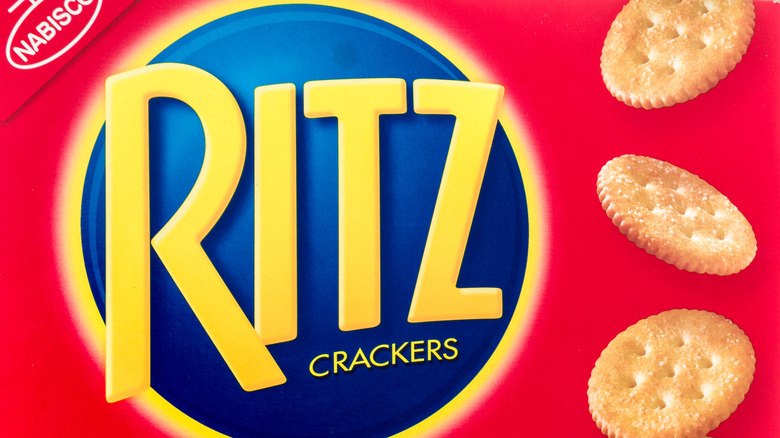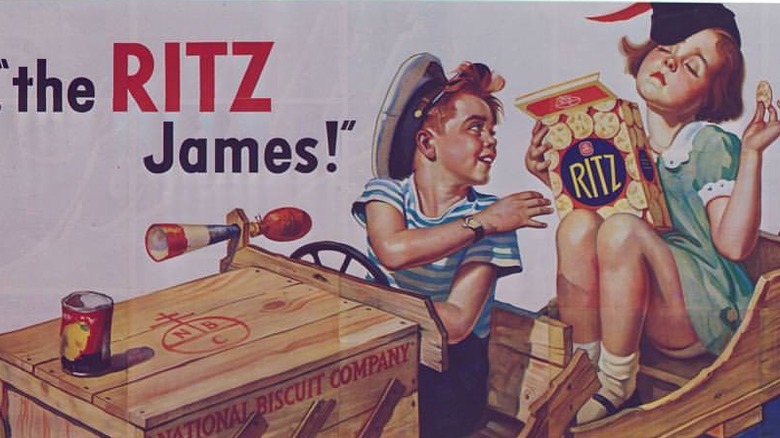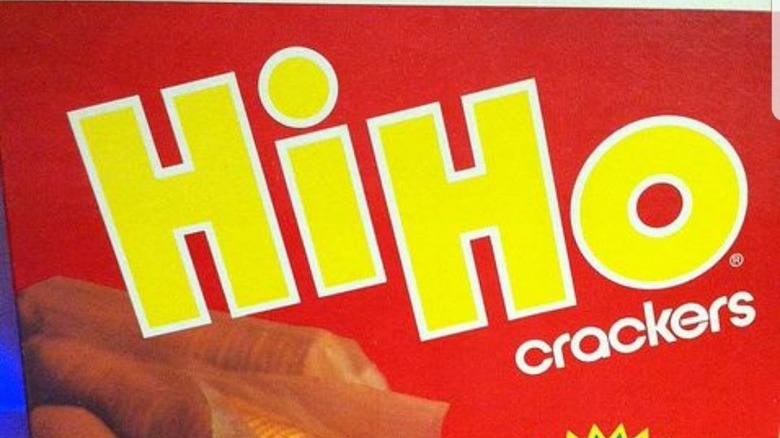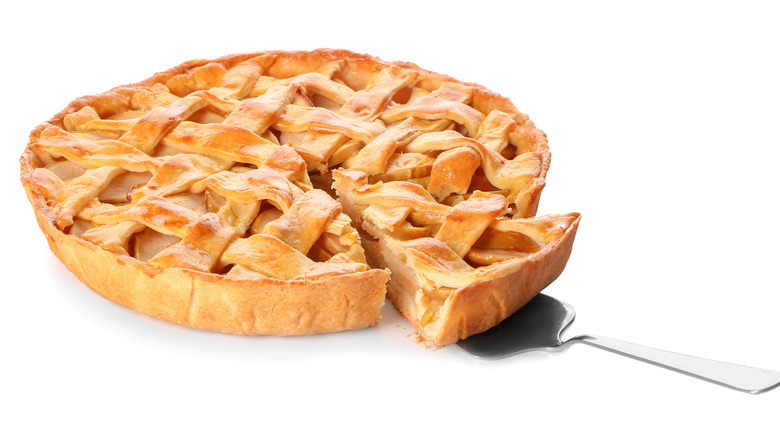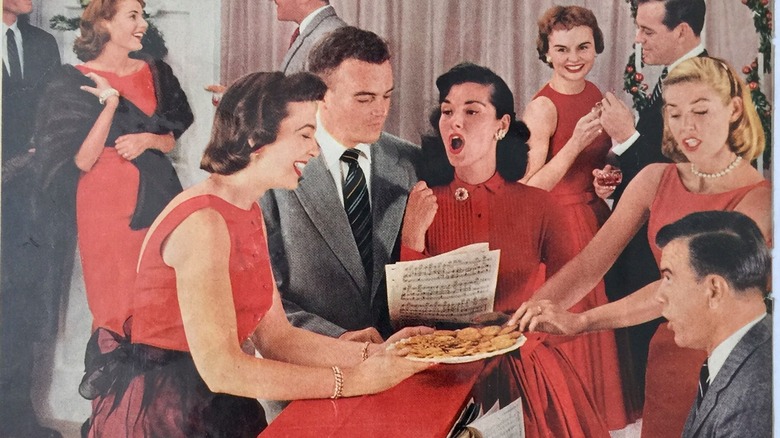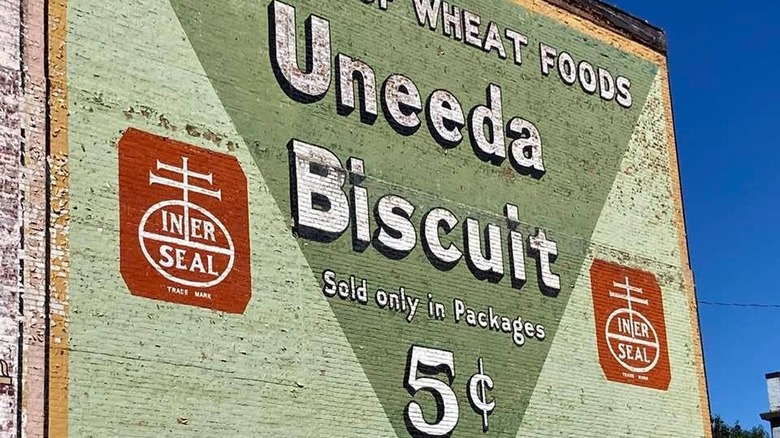The Untold Truth Of Ritz Crackers
Ritz Crackers are a universal favorite. They've been a comforting fixture in grocery stores for over 80 years. Ritz are the perfect balance of salty, crispy, and buttery, and since they contain no actual butter even vegans can eat them! Whether you use them as an edible charcuterie board or as a cheese knife, Ritz crackers are always the life of the party.
Anything that's been on this Earth for the better part of nine decades is going to have some stories to show for it, and Ritz are no exception. The story of Ritz crackers follows the most important events in American history, from the industrialization of the 19th century to the tribulations of the Great Depression and the triumph of packaged convenience foods after World War II. Ritz's manufacturer Nabisco has been one of the biggest players in American snacks for longer than any of us has been alive, and they didn't always play fair. This is the untold truth of Ritz crackers.
Ritz have their roots in maritime history
The American cracker that we all know and love today originated in the late 18th century as a New England variation on hardtack. An essay in the New England Historical Society explains that hardtack, a kind of bread baked until it has no water content left, has been a staple of soldiers' and sailors' rations for hundreds of years. Hardtack was prized for its shelf life, surviving decades if stored properly. However, it was hard as a rock and not very tasty. Bakers in New England solved this problem by adding leavening, producing a tasty cracker more like what we enjoy today.
Former seaman Josiah Bent started producing leavened crackers in 1801, further refining the so-called "common cracker" by manufacturing smaller water crackers. Bent's bakery was one of several operations in the Northeast that consolidated into the New York Biscuit Company, which merged with another bakery to form the National Biscuit Company, or Nabisco, in 1898 (via ThoughtCo). Nabisco went on to dominate the cracker industry, developing Ritz crackers in 1934 (via Food Timeline).
Ritz were marketed as an affordable luxury in the Great Depression
When Ritz crackers were released at the height of the Great Depression, the name was associated with the epitome of luxury. Hotelier Cesar Ritz became famous in the first part of the 20th century for his fancy hotels, and anything calling itself Ritz in the 1930s was advertising itself as high-class. The book "A Century of American Icons" says that Nabisco capitalized on the brand's country club connotations in its early advertising, showing golfers and passengers on a luxury cruise ship being served Ritz crackers by uniformed attendants. The humble crackers really were perceived as fancy at the time, showing up on the menu at New York's swanky Waldorf-Astoria hotel.
Americans with tight wallets during the Great Depression viewed Ritz as an affordable way to get a little taste of a wealthy lifestyle. A mere 19 cents could procure a box of the same cracker that was being served to robber barons eating at expensive hotels. Ritz's advertising allowed consumers to fantasize about better times in the middle of great difficulties.
The name came from an artist's hat
Although Nabisco leveraged the luxurious reputation of the Ritz hotel brand in its ads, the crackers aren't actually named after Cesar Ritz's empire. Food and Wine writes that Nabisco commercial artist Sydney S. Stern was given one weekend to come up with a name and logo for the company's new buttery cracker. Pressed for time, the harried designer looked inside his hat and saw a pleasant circular logo on his hatband tag. Inspired, he painted the iconic blue and yellow Ritz logo. Initially, the higher-ups at Nabisco were worried that giving their cracker too rich of an image would backfire with customers, but as we've seen, Americans responded well to the elitist marketing. Sydney's original design stuck, and though details have been changed over the years, the Ritz logo today is still very similar to the 1934 version.
Sydney S. Stern was something of a package design savant, and Ritz wasn't his only iconic invention. He also designed the immediately recognizable Animal Cracker circus box as well as an updated logo for Shredded Wheat.
Ritz crackers were introduced as a copy of a competitor's product
Although Ritz's version ended up being the most popular butter cracker in the world, it was not the first. News-Graphic reports that Nabisco developed the recipe to compete with its rival Sunshine Biscuit. Sunshine's Hi Ho butter crackers ultimately couldn't survive the competition from Ritz, and they were discontinued after the company merged with Keebler (via AnswersToAll).
Ritz wasn't the only time Nabisco ripped off Sunshine. Atlas Obscura reveals that Nabisco's Oreos are a shameless copy of Sunshine's earlier Hydrox cookies. As with Hi Hos, Hydrox were eventually driven to extinction by Nabisco's superior marketing and distribution. Unlike the butter crackers, however, Hydrox got a new lease on life when Leaf purchased the name and started making their own version. Despite their competitor's corporate skulduggery, Sunshine got the last laugh. They still make America's most popular cracker, Cheez-Its, which according to Statista outsell Ritz by about $200 million a year.
Ritz served as apple pie during times of hardship
Ritz taste buttery, toasty, and salty. Apples taste sweet, sour, and juicy. You wouldn't think that you could make a convincing fake apple pie filling with Ritz crackers, but it actually works. The secret, according to iO9, is the cream of tartar, a powdered acid that's produced as part of the winemaking process. Since cream of tartar comes from grapes, it has a fruity flavor that infuses the crackers and makes them taste vaguely like apples.
Many people think that Nabisco invented mock apple pie to help sell more crackers during the Great Depression, but Culinary Lore debunks this myth. Although Nabisco popularized the recipe when they started printing it on cracker boxes during World War II, mock apple pie recipes have been found as far back as the 19th century, when they were usually made with saltines or water crackers. Although mock apple pie was created during a time when fresh fruit could be expensive and hard to come by, it's no longer a bargain compared to the real thing. Modern advances in growing and shipping technology have driven the price of fresh apples lower than the price of Ritz.
Ritz crackers were an instant success
By the time Nabisco introduced Ritz, they already dominated the cracker industry. The Gilded Age was a time of consolidation in American corporate life, with huge trusts like Standard Oil showing the advantages of combining competing businesses into large monopolies (via Ohio History Central). American Business History says that Nabisco's chairman A.W. Green used a combination of perfectionism, bullying, and Machiavellian scheming to take over the majority of America's cracker and biscuit production by the late 19th century. Some bakers resisted, splitting from the trust to form Sunshine, but they couldn't compete with Nabisco's muscle.
It's no wonder that within a year of their release, Ritz crackers swamped all of their competitors. By 1935, less than 24 months after their debut, Ritz had already sold 5 billion crackers (via The Saturday Evening Post). At the time, that meant that on average, every person in America ate 40 Ritz a year. Ritz eclipsed every other cracker in stores, swiftly becoming the most popular cracker in the global market.
Ritz is still America's favorite snack
Ritz might not be America's best-selling cracker anymore, but sales figures aren't the only way to measure popularity. Insider reports that a YouGov poll of American consumers rated Ritz as not just America's favorite cracker, but its favorite overall snack brand. Rather than measuring purchases, YouGov conducted this study by asking people how they felt about brands on a scale of -100 to 100. It was close, but Ritz edged out Lays with an average score of 54 to 52.5. These brands were the only two to score over 50 in the survey.
Digital Media Solutions argues that nostalgia is one of the most important factors that encourage consumers to develop brand loyalty. Nostalgia incites a heightened sense of emotion that brands can take advantage of to create positive associations. Nabisco and Ritz have been around for as long as most of us can remember, and many of us have fond childhood memories that involve Nabisco brands. We turn to Ritz for comfort just as our grandparents in the Great Depression did.
Those holes in Ritz crackers serve an important purpose
The seven holes on each cracker are a key component of Ritz's classic look, but they're not just for show. They also ensure the cracker's quality (via Today I Found Out). Crackers need to be flat and crispy, but dough tends to rise in the oven. Cracker factories combat this by using a device called a docker that punches holes in the dough before it's baked. The holes allow steam to cook out of the dough, which prevents it from puffing up. They also promote even baking. The distance between the holes must be precisely calibrated to release the correct amount of moisture during the bake time to achieve the desired texture.
The number of holes in different types of crackers has long fascinated the snack-buying public. They might be overthinking things, though, because The South Florida Sun-Sentinel quotes a Keebler representative as saying "Why are there 13 holes in saltines, while graham crackers have various numbers and a Cheez-It has a sole hole?" Well, apparently: "It just turns out that way."
Ritz benefited from an innovation in snack packaging technology
The History of Branding profile of Nabisco notes that novel packaging design was a key contributor to the corporation's early success. When the company developed a new, fresher-tasting cracker called the Uneeda biscuit, they realized that traditional packaging would allow the delicate crackers to go stale long before they reached customers. At the time, some stores still sold crackers out of antiquated barrels that allowed mice, rats, and other pets access to the exposed biscuits (via American Business History).
A.W. Green's solution to this problem was an innovative double-layer packaging system called Inner-Seal. The new biscuits arrived at stores sheathed in a wax paper bag inside of a cardboard box. This style of packaging has become ubiquitous in subsequent decades, but at the time it was unique. The wax paper sealed out air and other contaminants while the cardboard protected the crackers from shattering. Nabisco's later offerings like Ritz, Oreos, and Milk Bones all stayed fresh because of Inner-Seal packaging.
They used to be owned by the maker of Camel cigarettes
You wouldn't think of cigarette companies as being suited to selling food, but according to American Business History, that didn't stop two different tobacco conglomerates from trying to find success by buying Nabisco. First, Camel manufacturer R.J. Reynolds bought Nabisco in 1985 as part of an effort to move away from tobacco. R.J. Reynolds brought a more ostentatious swagger to the company's C-suite, but then RJR Nabisco fell victim to a leveraged buyout by venture capital firm KKR. The new owners drove the company into debt and then re-listed it on the stock market at a deflated value.
Philip Morris, the company behind Marlboro cigarettes, swooped in and bought the struggling company in 2000 for almost $15 billion. Like R.J. Reynolds, Philip Morris proved ill-suited to running a food empire, and the company divested all its food brands six years after acquiring Nabisco. Snack food and cigarettes may both be addictive, but it turns out that Americans don't like buying their food and their poison from the same people.
